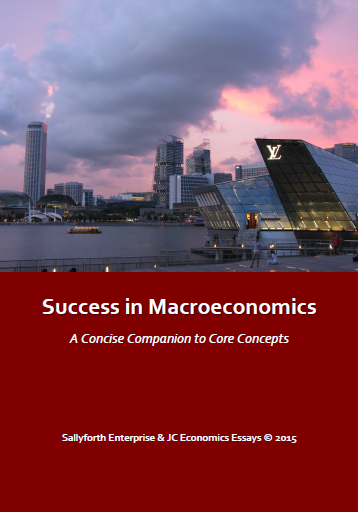Discuss if an increase in inflation is more likely to impact the domestic or the external sector of Singapore’s economy. [25]
Inflation is defined as a continuous and sustained increase in the general price level, and can be analysed as cost push or demand pull inflation, or a combination of such effects. Inflation causes problems for both the domestic and external sector of Singapore’s economy. However, it is more likely that the external sector of the economy will be worse hit, since Singapore is small and open. Inflation hurts the domestic sector because of the redistribution of income and lower economic growth and higher unemployment, which may lead to negative social issues. Yet, inflation also hurts the external sector because it hurts Singapore's export competitiveness and worsens the current account. In addition, we can expect a depreciation in the Singapore dollar, which hurts us even more because most if not all of Singapore’s inputs are imported from overseas.
Inflation hurts the domestic sector because of the redistribution of income and the impact on economic activity leading to lower economic growth and higher unemployment. First, the redistribution of income is in favour of variable income earners and not fixed income earners, and therefore many Singaporeans will suffer as they are wage earners. Borrowers will benefit from inflation and lenders will lose from inflation, and this will lower investment lending. Finally, people who hold Singapore government bonds will lose out because their Singapore government bond income cannot buy much due to inflation. In all, inflation hurts fixed income earners who are the bulk of Singapore’s workers, hurts banks and other lenders, and hurts people who own government or corporate bonds. Hence, inflation is damaging domestically due to the redistribution of income.
Secondly, if the inflation in Singapore is due to cost push inflation, unemployment will result, which hampers economic growth.
Insert cost push inflation diagram. Why does the author do this? Why this particular diagram? Think through the process of this essay to yourself. You can also try to draw out the diagram yourself from memory rather than referring to your Economics lecture notes.
According to the diagram above, increasing costs push the general price level upwards, while reducing employment from the full employment level. This is because consumption falls due to rising costs, and investment falls because of the uncertain market outlook. Singapore might face this problem if, for example, workers producing manufacturing goods for exports are laid off due to rising costs due to increased wage push. Furthermore, Singapore’s export oriented firms might face the need for retrenchments if there is imported inflation, since inputs used locally come from overseas. Thus, Singapore might face unemployment and dampened economic growth if there is cost push inflation, which might be likely as Singapore is a small and open economy that relies on foreign inputs to make goods.
On the flip side, inflation hurts the external sector as well because it hurts export competitiveness and hence worsens the balance of payments. In addition, we can expect the Sing dollar to depreciate, which hurts Singaporeans even more because most of inputs are imported from overseas. First, why would the current account worsen? This is because when there is inflation in Singapore, goods and services become more expensive relative to other countries’ goods and services, decreasing export competitiveness. This causes other countries to demand less of Singapore goods and hence the current account worsens, since it is (X – M), where X is falling. One can also argue that the capital account worsens, since due to worsening economic conditions, capital flight might occur and foreigners might pull capital out of Singapore. Therefore, the balance of payments worsens when inflation occurs.
Secondly, when other countries demand less of Singapore’s goods, this lowers the demand for the Singapore dollar and hence the Singapore dollar depreciates vis-à-vis other currencies. Even though the government uses a managed floating exchange rate system, the lack of demand for the Singapore currency will still lead to depreciation and a rise in the inputs that are imported. When inputs that are imported are more expensive, export competitiveness is once again further worsened in some kind of a spiraling effect and that makes the current account worsen even further. Thus, depreciation due to inflation is not a positive impact.
In conclusion, which hurts the most – the domestic or foreign? To a large extent, the external sector of the Singapore economy will be worse hit, as Singapore is a small and open economy and therefore reliant on imports and exports. The local domestic sector is also hit, but nonetheless the external sector is linked with the domestic sector, and problems with BOP and depreciation will also lead to unemployment and cost push inflation as well as lack of economic growth. Therefore, in the final analysis, the external sector is always worse hit than the domestic sector in Singapore as a general rule, but the two are actually closely and intimately allied, and eventually their impacts are almost always intertwined and interacting.
JC ECONOMICS ESSAYS Economics Tutor's Comments: An excellent and very well-written economics exam paper. This student answered the question well. Note: this Economics essay was written under model examination conditions.



